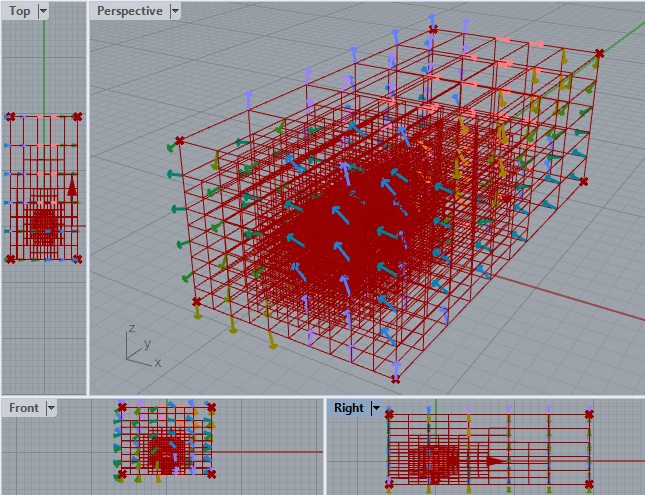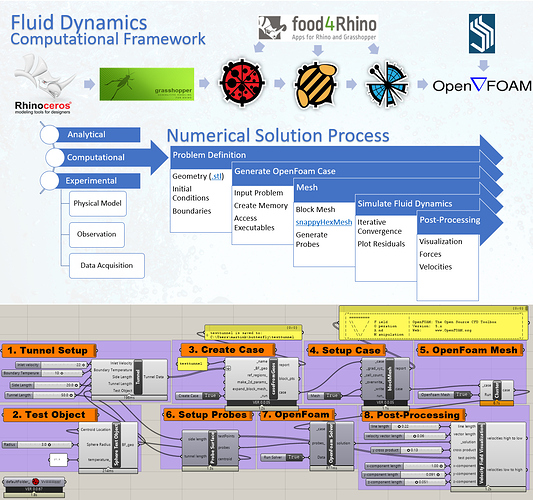Hello All,
The open-source tools of Ladybug, Butterfly, and OpenFoam are pretty incredible, and I would like to thank all those that played a part in the creation and implementation of these powerful tools.
I am working on a definition to describe the computational fluid dynamics process to students in a research program where I work. The model seems to function well, but I would like to extend the capabilities in Grasshopper, particularly in post-processing analysis and visualization. Ways to streamline and simplify the process and extend information are vital in communicating lessons, I would love to see streamlines or contour plots, but these elude me so far. Modifying fluid properties like density and viscosity also are beyond me at this point.
An updated program will evaluate flow fields around the test object geometry that can be changed out similarly to real wind tunnels. Eventually, the geometry will be 3-D printed, and a flow-field analysis conducted to compare results with attention on vortex stability, something that is beyond this version 1 model. However, I’m hopeful the OpenFoam framework has this capability.
Any feedback or comments would be much appreciated. Frankly, I’m just happy that everything installed and I was able to understand things well enough to create a working definition. Once I have the permissions, I will upload the definition for review and suggestions. Until then, I have included an image describing the general process with the hope that some may find it useful.
Thank you,
MCB
Hi,@martin.c.baker Thanks for your sharing. It is very nice. I love it. The iteration of butterfly is not as quick as Ladybug/Honeybee. I think you have developed some awesome new compotent for your research or project. I will always wait for the release of these compotent. By the way, could you like to share more screenshot of your custom compotent?
Hi Ming,
These were clusters that I made to support the post. I’ve made some progress and have run into some new challenges but am still working on answering the questions “Where do leaves collect? Where do snowdrifts form?”
I’ve asked this same question over on the McNeel forum (https://discourse.mcneel.com/t/read-butterfly-probe-field-information-and-apply-to-quelea-or-other-particles/98287) that has the definition that I’m working on to create a fluid flow definition with (semi-)realistic particle interactions. The idea is to take a generic geometry, find the fluid flow by doing CFD, and then introduce particles into the system to see where they collect under the influence of gravitational and fluid forces.
For the fluid flow, I have OpenFoam working through Ladybug + Butterfly (yay!) with probes located at all the mesh points measuring velocity and pressure fields. I am trying to get Quelea working for the particles, but so far, they are just two non-interacting systems. I would like to set the particle velocity from the Butterfly field data but am so far unable to get the Quelea agents to sense the mesh points field information.
A box environment makes the most sense because a poly surface environment for the Quelea causes problems since the OpenFoam blockMesh and snappyHexMesh are highly complex despite simplification and welds.
I can get the mesh points to show and do calculations with vectors just fine; it’s the particle interaction that I’m having trouble with, perhaps Quelea isn’t even a good approach. Any simulations with particles interacting with vector fields would probably work.

Everything works right up to particle interactions, then it grows pretty chaotic, and I decided to ask for help…(feeling like a noob  ).
).
Any thoughts or guidance would mean the world. If you see ways to streamline or speed things up, I would appreciate those insights as well.
Thank you,
MCB


 ).
).